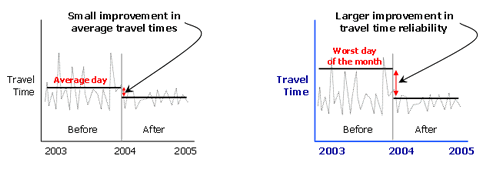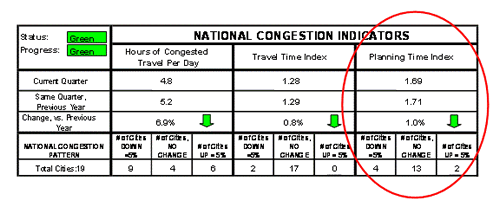Travel Time Reliability: Making It There On Time, All The Time
Traffic Congestion Is A Daily Reality In Most Of The Large Urban Areas In The United States
It's to be expected—large numbers of people all trying to reach their destinations at the same time, usually during peak hours. Drivers are used to the everyday congestion and they plan for it. They don't like it, but they leave home early enough to get to work on time. It's the unexpected congestion that troubles travelers the most from day to day. A trip that usually takes a half-hour, with little or no warning, takes an hour.
Now the motorist is late for work, has missed a doctor's appointment, or is facing hefty childcare penalties for picking up the kids late. Maybe a trucker gets held up in unexpected traffic, making shipments late to the manufacturer, disrupting just-in-time delivery, and losing the competitive edge on other shippers.
Travelers want travel time reliability—a consistency or dependability in travel times, as measured from day to day or across different times of day. Drivers want to know that a trip will take a half-hour today, a half-hour tomorrow, and so on.
Why Is Travel Time Reliability Important?
Most travelers are less tolerant of unexpected delays because such delays have larger consequences than drivers face with everyday congestion. Travelers also tend to remember the few bad days they spent in traffic, rather than an average time for travel throughout the year (see Figure 1).
Figure 1. Averages don't tell the full story
(Select figure to enlarge)
In order to improve travel time reliability, the first step is to measure it. Measures of travel time reliability better represent a commuter's experience than a simple average travel time. For example, a typical before-and-after study attempts to show the benefits of an incident management program (see Figure 2). Looking at average travel time, the improvement may seem modest. However, travel time reliability provides a different perspective of the improvement: the worst few days have been dramatically improved. Travelers make it to their destinations on time more often or with fewer significant delays.
Figure 2. Reliability measures capture the benefits of traffic management
(Select figure to enlarge)
How Do Agencies Measure Travel Time Reliability?
Travel time reliability measures are relatively new, but a few have proven effective. Most measures compare high-delay days to those with an average delay. The most effective methods of measuring travel time reliability are 90th or 95th percentile travel times, buffer index, and planning time index, explained in the following sections.
Several statistical measures, such as standard deviation and coefficient of variation, have been used to quantify travel time reliability. However, they are not easy for a nontechnical audience to understand and would be less-effective communication tools. They also treat early and late arrivals with equal weight. But the public cares much more about late arrivals.
90th or 95th percentile travel times
This method, the 90th or 95th percentile travel times, is perhaps the simplest method to measures travel time reliability. It estimates how bad delay will be on specific routes during the heaviest traffic days. The one or two bad days each month mark the 95th or 90th percentile, respectively. Users familiar with the route (such as commuters) can see how bad traffic is during those few bad days and plan their trips accordingly. This measure is reported in minutes (as shown in Figure 6).
Buffer index
The buffer index represents the extra time (or time cushion) that travelers must add to their average travel time when planning trips to ensure on-time arrival.
For example, a buffer index of 40 percent means that for a trip that usually takes 20 minutes a traveler should budget an additional 8 minutes to ensure on-time arrival most of the time.
Average travel time = 20 minutes
Buffer index = 40 percent
Buffer time = 20 minutes × 0.40 = 8 minutes
The 8 extra minutes is called the buffer time. Therefore, the traveler should allow 28 minutes for the trip in order to ensure on-time arrival 95 percent of the time.
Planning time index
The planning time index represents how much total time a traveler should allow to ensure on-time arrival. While the buffer index shows the additional travel time that is necessary, the planning time index shows the total travel time that is necessary (see Figure 3).
Figure 3. Reliability
measures compared to average congestion measures
(Source: http://mobility.tamu.edu/mmp/)
(Select figure to enlarge)
For example, a planning time index of 1.60 means that for a trip that takes 15 minutes in light traffic a traveler should budget a total of 24 minutes to ensure on-time arrival 95 percent of the time.
Free-flow travel time = 15 minutes
Planning time index = 1.60
Planning time = 15 minutes × 1.60 = 24 minutes
The planning time index is especially useful because it can be directly compared to the travel time index (a measure of average congestion) on similar numeric scales. The travel time index is a measure of average conditions that tells one how much longer, on average, travel times are during congestion compared to during light traffic.
Figure 3 illustrates the relationship between the buffer index and the planning time index. The buffer index represents the additional time that is necessary, whereas the planning time index represents the total travel time that is necessary.
How Does An Agency Begin Using Travel Time Reliability Measures?
Putting these methods to work requires an overall evaluation and implementation process. Figure 4 briefly shows the steps involved in measuring travel time reliability and how to put that information to work for travelers and traffic managers.
Who Is Currently Using Travel Time Reliability Measures?
Even though travel time reliability measures are relatively new, several agencies have already begun using them. Agencies such as the Federal Highway Administration (FHWA), Minnesota Department of Transportation (Mn/DOT), and the Washington State Department of Transportation (WSDOT) have primarily used travel time reliability as a performance measure to supplement measures of average congestion.
FHWA
FHWA supports a national traffic monitoring program that tracks reliability measures in more than 30 cities. FHWA communicates this information to key decision-makers through a monthly dashboard report (see Figure 5). The report includes trend information on the duration (hours of congested travel per day), magnitude (travel time index), and reliability (planning time index).
Figure 5. A reliability measure is included in FHWA's Monthly Congestion Dashboard Report.
(Select figure to enlarge)
Mn/DOT
In 2000, Mn/DOT used travel time reliability measures to study the effects of a ramp meter shutdown on Minneapolis-St. Paul freeways. In this study, Mn/DOT reported that turning off the ramp metering system caused travel time reliability to worsen by 91 percent. In comparison, the average travel times worsened by only 22 percent. These findings supported the concepts presented in Figure 2—operational improvements have a greater effort on day-to-day travel time reliability than on average travel times. As a result of this legislatively mandated study, Mn/DOT was able to continue operating its ramp metering program in 2001.
WSDOT
WSDOT tracks travel time reliability in its performance-monitoring efforts and provides reliability estimates to commuters. A page on the WSDOT website (see Figure 6) allows commuters to select a trip and generate a 95th percentile travel time based on historical data. Commuters can then use the travel time estimate to ensure they arrive on time for that particular trip.
Figure 6. WSDOT
provides reliability measures for traveler information
(Source: http://www.wsdot.wa.gov/traffic/seattle/traveltimes/reliability/)

WSDOT also uses reliability measures in reporting the performance of freeways and high-occupancy vehicle (HOV) lanes (http://depts.washington.edu/hov). In particular, WSDOT uses the 90th percentile travel time and the frequency of congestion performance measures to determine operating strategies and prioritize improvements.
Where Can I Find More Information?
A guide to travel time reliability is available at http://www.ops.fhwa.dot.gov/. It contains supporting information and technical details on developing travel time reliability measures.
Contact Information
For more information, contact:
Rich Taylor, FHWA
(202) 366-1327
Rich.Taylor@fhwa.dot.gov
FHWA-HOP-06-070



